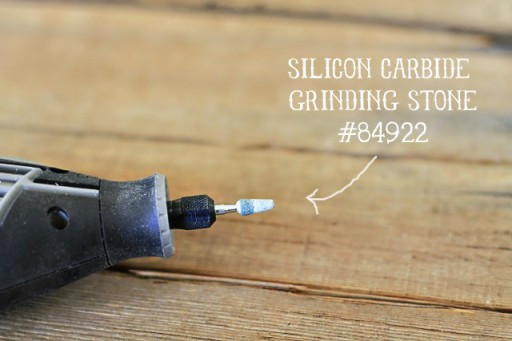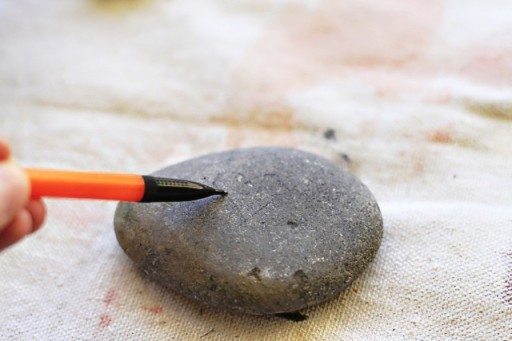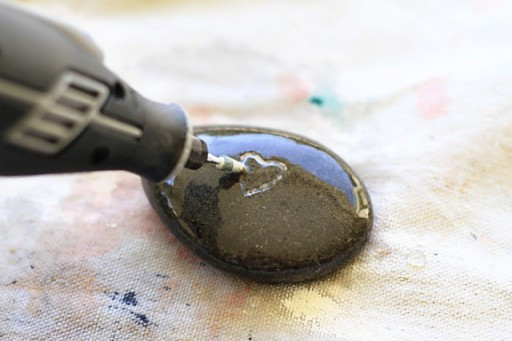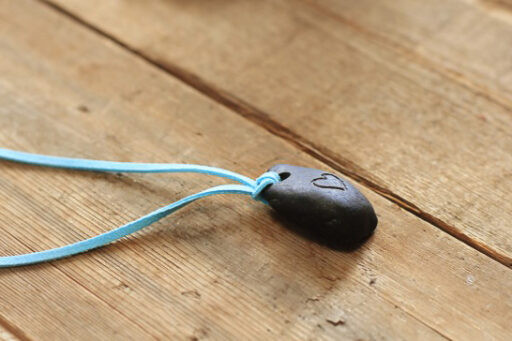Cutting rock with a Dremel can unlock a world of creative possibilities for your rockscapes.net projects. This guide offers expert tips and techniques for using a Dremel to shape, carve, and drill rocks, adding unique natural stone touches to your landscape and DIY projects. We’ll cover everything from choosing the right Dremel bits to safety precautions and inspiring ideas for your next rock project, using rock carving tools and rotary tools.
1. What Is a Dremel and Why Use It to Cut Rock?
A Dremel is a versatile rotary tool known for its high speed and ability to accommodate various attachments, making it ideal for detailed work on various materials. Using a Dremel to cut rock offers precision, control, and the ability to create intricate designs that would be difficult to achieve with larger tools; its adaptability makes it a favorite among DIY enthusiasts and professional landscapers alike.
A Dremel rotary tool is a lightweight, handheld power tool that uses a high-speed motor to rotate various bits and attachments. This allows the Dremel to perform a wide range of tasks, including:
- Cutting: Slicing through materials like wood, metal, plastic, and, yes, even rock.
- Grinding: Smoothing rough edges, removing material, and shaping surfaces.
- Carving: Creating decorative designs and patterns.
- Drilling: Making holes for mounting or decorative purposes.
- Polishing: Giving materials a smooth, shiny finish.
1.1 What are the benefits of using a Dremel for rock cutting?
Using a Dremel for rock cutting has several benefits:
- Precision: Dremels offer excellent control for intricate cuts and designs.
- Versatility: A wide range of attachments allows for various cutting, grinding, and polishing tasks.
- Portability: Its compact size makes it easy to maneuver in tight spaces.
- Cost-Effectiveness: Dremels are a relatively affordable option compared to larger cutting tools.
1.2 What are the limitations of using a Dremel for rock cutting?
Despite the benefits, Dremels also have limitations:
- Size Restrictions: Dremels are best suited for smaller rocks and detailed work.
- Time Consumption: Cutting through harder rocks can be time-consuming.
- Bit Wear: Rock cutting can quickly wear down bits, requiring frequent replacements.
2. Identifying the Right Dremel and Accessories for Rock Cutting
Selecting the right Dremel and accessories is crucial for effective rock cutting. Different models offer varying power levels and speed controls, while specific attachments are designed for cutting, grinding, and polishing stone.
2.1 What type of Dremel is best for cutting rock?
The best Dremel for rock cutting depends on the size and hardness of the rocks you plan to work with. Here’s a breakdown:
- For Softer Rocks (e.g., sandstone, shale): A basic Dremel model with variable speed settings will suffice.
- For Harder Rocks (e.g., granite, quartz): A more powerful Dremel with higher RPM (revolutions per minute) is recommended. Cordless models like the Dremel 8220 offer flexibility, while corded models provide consistent power for extended use.
2.2 What are the essential Dremel attachments for rock cutting?
Several attachments are essential for cutting and shaping rocks with a Dremel:
- Diamond Cutting Wheel: Ideal for cutting through hard rocks.
- Silicon Carbide Grinding Stone: Suitable for shaping and smoothing softer rocks.
- Diamond Grinding Bits: Used for detailed carving and engraving.
- Polishing Wheels and Compounds: For achieving a smooth, glossy finish.
 Silicon Carbide Grinding Stone is suitable for shaping and smoothing softer rocks in rockscapes.net
Silicon Carbide Grinding Stone is suitable for shaping and smoothing softer rocks in rockscapes.net
2.3 Where can I find these Dremel accessories?
Dremel accessories are widely available at:
- Hardware Stores: Local hardware stores like Home Depot and Lowe’s carry a variety of Dremel tools and accessories.
- Online Retailers: Amazon offers a vast selection of Dremel products with customer reviews and competitive pricing.
- Specialty Tool Stores: Stores specializing in tools and machinery often have a more comprehensive selection of high-quality Dremel attachments.
3. Preparing Your Rock for Cutting with a Dremel
Before you begin cutting, preparing your rock properly ensures a safer and more efficient process. Cleaning the rock, marking your design, and securing it in place are essential steps.
3.1 How do I clean the rock before cutting?
Cleaning the rock removes dirt, debris, and any loose particles that could interfere with the cutting process. Follow these steps:
- Rinse the Rock: Use a hose or running water to remove loose dirt.
- Scrub the Surface: Use a stiff brush and soapy water to scrub the rock’s surface.
- Rinse Again: Thoroughly rinse the rock to remove any soap residue.
- Dry the Rock: Allow the rock to air dry completely before proceeding.
3.2 How do I mark the cutting line on the rock?
Marking the cutting line accurately ensures you follow your design precisely. Here’s how:
- Sketch Your Design: Use a pencil or marker to sketch your design directly onto the rock. For complex designs, consider using stencils or templates.
- Use a Template: If you’re using a template, secure it to the rock with tape and trace the design onto the surface.
- Reapply as Needed: Depending on the rock type, you may need to reapply the lines during cutting due to them fading.
 Marking the cutting line accurately ensures you follow your design precisely with rockscapes.net
Marking the cutting line accurately ensures you follow your design precisely with rockscapes.net
3.3 How do I secure the rock for cutting?
Securing the rock prevents it from moving during cutting, which could lead to inaccurate cuts or accidents. Consider these methods:
- Vise: A vise is a sturdy tool that can hold the rock securely in place. Use padding (e.g., cloth or rubber) to protect the rock’s surface from damage.
- Clamps: Clamps can be used to secure the rock to a workbench or other stable surface.
- Non-Slip Mat: Placing a non-slip mat under the rock can help prevent it from sliding.
- Sandbag: Surrounding the rock with a sandbag can provide additional stability.
4. Step-by-Step Guide: Cutting Rock with a Dremel
With the right tools and preparation, cutting rock with a Dremel is a straightforward process. Follow these steps for safe and effective rock cutting.
4.1 What safety precautions should I take before cutting?
Safety is paramount when working with power tools. Always wear appropriate safety gear:
- Safety Glasses: Protect your eyes from flying debris.
- Dust Mask: Prevent inhalation of rock dust, which can be harmful.
- Gloves: Protect your hands from cuts and abrasions.
- Ear Protection: Reduce noise exposure, especially during prolonged use.
4.2 How do I properly hold and control the Dremel while cutting?
Proper grip and control are essential for accurate and safe cutting:
- Comfortable Grip: Hold the Dremel firmly but comfortably, allowing for precise movements.
- Two-Handed Control: Use both hands to guide the Dremel for better stability and control.
- Slow and Steady: Move the Dremel slowly and steadily along the cutting line, letting the tool do the work. Avoid applying excessive pressure, which can cause the bit to break or the Dremel to slip.
4.3 What cutting techniques should I use for different types of rock?
Different rocks require different cutting techniques. Here are some tips:
- Softer Rocks: Use a lower speed setting and a silicon carbide grinding stone. Apply gentle pressure and make multiple passes to gradually cut through the rock.
- Harder Rocks: Use a higher speed setting and a diamond cutting wheel or grinding bit. Apply steady, even pressure and keep the rock cool by frequently dipping it in water.
- Detailed Carving: Use diamond grinding bits for intricate designs. Work slowly and carefully, making small, controlled movements.
4.4 How do I prevent overheating during cutting?
Overheating can damage the Dremel, the cutting bit, and the rock itself. Prevent overheating by:
- Using Water: Frequently dip the rock and the cutting bit in water to keep them cool.
- Taking Breaks: Allow the Dremel to cool down periodically, especially during extended use.
- Adjusting Speed: Use a lower speed setting to reduce friction and heat buildup.
 Engraving River Rocks with a Dremel and frequently dipping it in water to prevent overheating for rockscapes.net
Engraving River Rocks with a Dremel and frequently dipping it in water to prevent overheating for rockscapes.net
5. Advanced Techniques for Rock Cutting with a Dremel
Once you’ve mastered the basics, you can explore advanced techniques to enhance your rock-cutting skills. These include creating intricate designs, drilling holes, and polishing your finished pieces.
5.1 How can I create intricate designs on rocks with a Dremel?
Creating intricate designs requires patience, precision, and the right tools:
- Detailed Sketch: Start with a detailed sketch of your design on the rock.
- Small Grinding Bits: Use small diamond grinding bits to carve fine lines and details.
- Multiple Passes: Make multiple light passes instead of trying to remove too much material at once.
- Varying Depths: Vary the depth of your cuts to create texture and dimension.
5.2 What is the best way to drill holes in rocks using a Dremel?
Drilling holes in rocks can be useful for creating jewelry, attaching decorative elements, or making water features:
- Diamond Core Drill Bits: Use diamond core drill bits specifically designed for drilling through stone.
- Water Lubrication: Continuously lubricate the drill bit and the rock with water to prevent overheating and reduce wear.
- Low Speed: Use a low speed setting and apply gentle, steady pressure.
- Pilot Hole: Start with a small pilot hole and gradually increase the size of the hole as needed.
5.3 How do I polish rocks after cutting them with a Dremel?
Polishing rocks enhances their natural beauty and brings out their color and texture:
- Sanding: Start by sanding the rock with progressively finer grits of sandpaper to remove any scratches or rough edges.
- Polishing Wheels: Use polishing wheels and compounds to achieve a smooth, glossy finish.
- Buffing: Buff the rock with a soft cloth or polishing pad to bring out the shine.
- Beeswax: Applying beeswax with a polishing wheel can add an extra shine.
 Use Beeswax to polish rock with a Dremel after cutting them for rockscapes.net
Use Beeswax to polish rock with a Dremel after cutting them for rockscapes.net
6. Creative Rock Cutting Project Ideas Using a Dremel
With a Dremel, the possibilities for creative rock projects are endless. Here are some inspiring ideas to get you started.
6.1 Can I create personalized garden stones with a Dremel?
Creating personalized garden stones adds a unique touch to your landscape:
- Engrave Names or Quotes: Engrave family names, inspirational quotes, or meaningful dates onto smooth river rocks.
- Create Plant Markers: Make custom plant markers by engraving the names of herbs, flowers, or vegetables onto small stones.
- Design Decorative Pathways: Create a decorative pathway by arranging engraved stones with intricate designs or patterns.
6.2 What are some DIY rock jewelry ideas using a Dremel?
Making your own rock jewelry is a fun and creative way to showcase the natural beauty of stones:
- Pendants: Drill holes in small, polished stones and attach them to necklaces or bracelets.
- Earrings: Create unique earrings by attaching small, carved stones to earring hooks.
- Rings: Use epoxy to attach small, flat stones to ring blanks.
 DIY Rock Accessories using a Dremel for rockscapes.net
DIY Rock Accessories using a Dremel for rockscapes.net
6.3 How can I make decorative rock sculptures with a Dremel?
Creating decorative rock sculptures allows you to express your artistic vision and add a natural element to your home or garden:
- Abstract Sculptures: Stack and arrange rocks of varying sizes and shapes, using a Dremel to carve and shape them as needed.
- Animal Figurines: Carve animal shapes from larger rocks using diamond grinding bits.
- Miniature Landscapes: Create miniature landscapes by arranging small rocks, plants, and other decorative elements on a tray or in a terrarium.
7. Maintaining Your Dremel and Accessories for Longevity
Proper maintenance ensures your Dremel and accessories last longer and perform optimally. Clean your tools after each use, store them properly, and replace worn parts as needed.
7.1 How often should I clean my Dremel and accessories?
Cleaning your Dremel and accessories after each use prevents buildup of dust and debris, which can affect performance and shorten their lifespan.
7.2 What is the best way to store my Dremel and accessories?
Store your Dremel and accessories in a clean, dry place to protect them from moisture and damage:
- Original Case: Store the Dremel in its original case or a similar protective container.
- Accessory Organizer: Use an accessory organizer or storage case to keep your bits and attachments organized and easily accessible.
- Dry Environment: Avoid storing your Dremel in humid environments, which can cause corrosion.
7.3 How do I know when to replace my Dremel bits?
Replace your Dremel bits when they show signs of wear, such as:
- Reduced Cutting Efficiency: If the bit is no longer cutting as quickly or effectively as it used to.
- Visible Damage: If the bit is chipped, cracked, or otherwise damaged.
- Rounded Edges: If the cutting edges of the bit are rounded or dull.
8. Troubleshooting Common Issues When Cutting Rock with a Dremel
Even with the best preparation, you may encounter issues when cutting rock with a Dremel. Here are some common problems and solutions.
8.1 What should I do if my Dremel bit keeps breaking?
If your Dremel bit keeps breaking, consider the following:
- Excessive Pressure: Reduce the amount of pressure you’re applying to the bit. Let the tool do the work.
- Incorrect Speed: Use the appropriate speed setting for the type of rock you’re cutting.
- Overheating: Keep the bit and the rock cool by frequently dipping them in water.
- Worn Bit: Replace the bit with a new one.
8.2 How do I prevent the rock from chipping while cutting?
Preventing chipping ensures clean, precise cuts:
- Sharp Bit: Use a sharp, new cutting bit.
- Slow Speed: Use a slow speed setting.
- Gentle Pressure: Apply gentle, even pressure.
- Cutting Direction: Cut in a direction that minimizes the risk of chipping (e.g., from the edge of the rock towards the center).
8.3 What if my Dremel is overheating?
Overheating can damage your Dremel. If your Dremel is overheating:
- Stop Cutting: Stop cutting immediately and allow the Dremel to cool down.
- Reduce Speed: Use a lower speed setting.
- Take Breaks: Take frequent breaks to allow the Dremel to cool down.
- Check Ventilation: Ensure the Dremel’s ventilation slots are not blocked.
9. The Geology of Rock Cutting: Understanding Rock Types and Their Properties
Understanding the geological properties of different rock types is essential for effective cutting.
9.1 What are the different types of rocks commonly used in landscaping?
Common types of rocks used in landscaping include:
- Granite: A hard, durable igneous rock that is resistant to weathering.
- Sandstone: A sedimentary rock composed of sand-sized grains, which is relatively soft and easy to carve.
- Slate: A metamorphic rock that splits into thin, flat sheets, ideal for pathways and walls.
- Limestone: A sedimentary rock composed primarily of calcium carbonate, which is relatively soft and easy to shape.
- River Rock: Smooth, rounded rocks that have been shaped by flowing water, often used for decorative purposes.
9.2 How does the hardness of a rock affect the cutting process?
The hardness of a rock directly affects the cutting process:
- Harder Rocks: Require more powerful tools, diamond cutting bits, and more time to cut.
- Softer Rocks: Can be cut more easily with basic tools and silicon carbide grinding stones.
9.3 Are there any rocks that should not be cut with a Dremel?
Some rocks are not suitable for cutting with a Dremel due to their extreme hardness or composition:
- Diamond: One of the hardest known materials, requiring specialized cutting equipment.
- Extremely Hard Igneous Rocks: Such as basalt, may be too difficult to cut efficiently with a Dremel.
10. Expert Tips and Tricks for Rock Cutting Success
To elevate your rock-cutting skills, consider these expert tips and tricks.
10.1 Can you share some professional tips for achieving clean cuts?
Professional tips for achieving clean cuts include:
- Sharp Bits: Always use sharp, high-quality cutting bits.
- Steady Hand: Maintain a steady hand and apply even pressure.
- Cutting Fluid: Use a cutting fluid (e.g., water) to lubricate the bit and reduce friction.
- Practice: Practice on scrap pieces of rock to hone your technique.
10.2 What are some innovative ways to use cut rocks in landscaping?
Innovative ways to use cut rocks in landscaping include:
- Water Features: Create custom water features by carving and shaping rocks to direct the flow of water.
- Retaining Walls: Use cut stones to build decorative retaining walls.
- Fire Pits: Design unique fire pits using cut and shaped rocks. According to research from Arizona State University’s School of Earth and Space Exploration, the use of natural stone in outdoor fire pits can significantly enhance the aesthetic appeal and blend seamlessly with the natural environment.
Address: 1151 S Forest Ave, Tempe, AZ 85281, United States. Phone: +1 (480) 965-9011. Website: rockscapes.net.
10.3 How can I incorporate lighting into my rock cutting projects?
Incorporating lighting can enhance the visual appeal of your rock projects, especially at night:
- Embedded Lights: Embed LED lights into carved rocks to create illuminated sculptures or pathways.
- Backlighting: Use backlighting to highlight the texture and detail of carved rocks.
- Spotlighting: Use spotlights to accentuate specific features of your rock creations.
FAQ: Cutting Rock with a Dremel
1. Is it safe to cut rock with a Dremel?
Yes, if you follow proper safety precautions, such as wearing safety glasses, a dust mask, and gloves.
2. What kind of Dremel bit should I use to cut rock?
Use a diamond cutting wheel or diamond grinding bit for hard rocks and a silicon carbide grinding stone for softer rocks.
3. How do I prevent my Dremel from overheating when cutting rock?
Frequently dip the rock and the cutting bit in water to keep them cool, and take breaks during extended use.
4. Can I cut large rocks with a Dremel?
Dremels are best suited for smaller rocks and detailed work. Larger rocks may require more powerful tools.
5. How do I clean rocks before cutting them with a Dremel?
Rinse the rocks with water, scrub them with a brush and soapy water, and allow them to dry completely before cutting.
6. How do I mark a cutting line on a rock?
Use a pencil or marker to sketch your design directly onto the rock. For complex designs, consider using stencils or templates.
7. How do I secure a rock while cutting it with a Dremel?
Use a vise, clamps, a non-slip mat, or a sandbag to hold the rock securely in place.
8. What should I do if my Dremel bit keeps breaking?
Reduce the amount of pressure you’re applying, use the appropriate speed setting, and keep the bit and rock cool.
9. How do I prevent the rock from chipping while cutting?
Use a sharp bit, a slow speed, and gentle pressure, and cut in a direction that minimizes the risk of chipping.
10. How do I polish rocks after cutting them with a Dremel?
Start by sanding the rock with progressively finer grits of sandpaper, then use polishing wheels and compounds to achieve a smooth, glossy finish.
Unleash your creativity and transform ordinary rocks into stunning works of art with a Dremel! Whether you’re aiming to personalize your garden with engraved stones or craft intricate rock sculptures, rockscapes.net provides the inspiration, information, and expert advice you need. Explore our extensive collection of rock types, innovative design ideas, and detailed tutorials to embark on your rock-cutting journey. Let rockscapes.net be your guide to creating breathtaking natural stone landscapes. Visit rockscapes.net today and discover the endless possibilities that await!